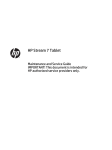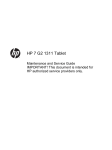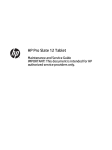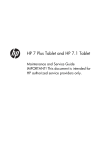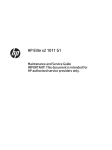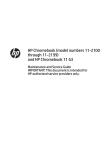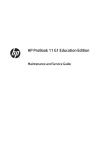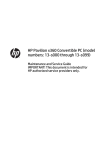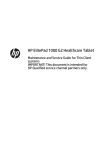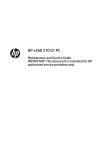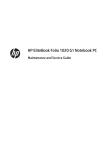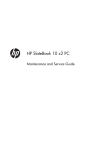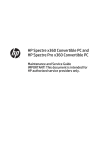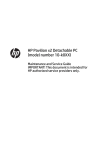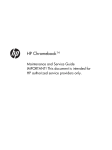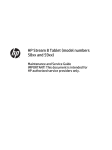Download User-Manual - Newegg.com
Transcript
HP Pro Tablet 408 G1 Maintenance and Service Guide IMPORTANT! This document is intended for HP authorized service providers only. © Copyright 2015 Hewlett-Packard Development Company, L.P. Bluetooth is a trademark owned by its proprietor and used by Hewlett-Packard Company under license. Intel is a U.S. registered trademark of Intel Corporation. Microsoft, Windows is a U.S. registered trademark of Microsoft Corporation. SD Logo is a trademark of its proprietor. The information contained herein is subject to change without notice. The only warranties for HP products and services are set forth in the express warranty statements accompanying such products and services. Nothing herein should be construed as constituting an additional warranty. HP shall not be liable for technical or editorial errors or omissions contained herein. First Edition: January 2015 Document Part Number: 798824-001 Product notice This guide describes features that are common to most models. Some features may not be available on your tablet. Software terms By installing, copying, downloading, or otherwise using any software product preinstalled on this tablet, you agree to be bound by the terms of the HP End User License Agreement (EULA). If you do not accept these license terms, your sole remedy is to return the entire unused product (hardware and software) within 14 days for a refund subject to the refund policy of your place of purchase. For any further information or to request a full refund of the tablet, please contact your local point of sale (the seller). Safety warning notice WARNING! To reduce the possibility of heat-related injuries or of overheating the device, do not place the device directly on your lap or obstruct the device air vents. Use the device only on a hard, flat surface. Do not allow another hard surface, such as an adjoining optional printer, or a soft surface, such as pillows or rugs or clothing, to block airflow. Also, do not allow the AC adapter to contact the skin or a soft surface, such as pillows or rugs or clothing, during operation. The device and the AC adapter comply with the useraccessible surface temperature limits defined by the International Standard for Safety of Information Technology Equipment (IEC 60950). iii iv Safety warning notice Table of contents 1 Product description ....................................................................................................................................... 1 2 External component identification ................................................................................................................. 3 3 Illustrated parts catalog ................................................................................................................................ 5 Locating the product number and serial number ................................................................................................. 5 Tablet major components ..................................................................................................................................... 6 Miscellaneous parts ............................................................................................................................................... 7 4 Removal and replacement preliminary requirements ....................................................................................... 9 Tools required ........................................................................................................................................................ 9 Service considerations ........................................................................................................................................... 9 Plastic parts ......................................................................................................................................... 9 Cables and connectors ........................................................................................................................ 9 Grounding guidelines ........................................................................................................................................... 10 Electrostatic discharge damage ....................................................................................................... 10 Packaging and transporting guidelines ......................................................................... 11 Workstation guidelines ................................................................................ 11 5 Removal and replacement procedures ........................................................................................................... 13 Tablet component replacement procedures ...................................................................................................... 13 Unlocking the device and disabling Always On Remote Management ............................................................... 13 Back cover ............................................................................................................................................................ 14 Middle frame and battery .................................................................................................................................... 15 WWAN antenna .................................................................................................................................................... 17 Rear-facing webcam ............................................................................................................................................ 19 System board ....................................................................................................................................................... 20 GPS antenna ........................................................................................................................................................ 23 Transfer board ..................................................................................................................................................... 24 Display panel cable .............................................................................................................................................. 26 Front-facing webcam .......................................................................................................................................... 27 WLAN antenna ..................................................................................................................................................... 28 Speakers .............................................................................................................................................................. 29 v 6 Using HP PC Hardware Diagnostics (UEFI) ...................................................................................................... 31 Downloading HP PC Hardware Diagnostics (UEFI) to a USB device .................................................................... 31 7 Specifications ............................................................................................................................................. 32 8 Backup and recovery .................................................................................................................................... 33 Backing up your information ............................................................................................................................... 33 Performing a system recovery ............................................................................................................................ 33 Changing the boot device order ........................................................................................................ 34 Using Windows Refresh or Windows Reset ...................................................................................... 34 9 Power cord set requirements ........................................................................................................................ 35 Requirements for all countries ........................................................................................................................... 35 Requirements for specific countries and regions ............................................................................................... 35 10 Statement of Volatility .............................................................................................................................. 37 Non-volatile memory usage ................................................................................................................................ 38 Questions and answers ....................................................................................................................................... 40 Using HP Sure Start (select models only) ........................................................................................................... 41 11 Recycling .................................................................................................................................................. 42 Index ............................................................................................................................................................. 43 vi 1 Product description Category Description Product Name HP Pro Tablet 408 G1 Processor Intel® Atom Z3736F 1.33-quad core processor soldered-on-circuit (SoC) Panel 8.0-in, (1280×800), high-definition (HD), 10-point capacitive TouchScreen display assembly Graphics Internal graphics: Integrated Intel universal memory architecture (UMA) graphics Memory On-board; non-accessible 2-GB DDR3L (4-Gbit, 256-MB × 16, Qty=4) Mass storage Supports 32- or 64-GB eMMC Audio and video Stereo speakers (2, 0.7-W) Single digital microphone 2.0-MP, fixed-focus front-facing webcam with activity light 8.0-MP, auto-focus rear-racing webcam with flash Sensor Accelerometer Ambient Light Sensor eCompass GPS/AGPS/Glonass Gyroscope Hall sensor SAR sensor Network GSM/GPRS/EDGE: Band 2/3/5/8 WCDMA: Band 1/2/4/5/8 Wireless networking Wireless local area network (WLAN): 802.11a/b/g/n (2.4-GHz, 5.0-GHz) dual band 2×2 Bluetooth: 4.0 LE SIM card Micro Subscriber Identity Module (SIM) connector Support for HP Mobile Connect External expansion Micro Secure Digital (SD), expandable up to 128-GB Ports ● Type B micro USB 2.0 port with host mode ● 3.5-mm audio jack (4-pole stereo), support for both CTIA and OMTP ● Micro HDMI Power requirements Supports a 4800-mAh, Li-Ion battery (non-removable), USB charging Supports a 10-W (5.3-V / 2-A) AC adapter with duck head adapter and localized cable plug support Operating system Windows 8.1 with Bing and Office 365 Personal for Small Tablets AFO Multilingual 32-bit 1 Category Description Operating system (continued) Windows 8.1 with Bing for Small Tablets Multilingual 32-bit Windows 8.1 with Bing for Small Tablets Chinese 32-bit Windows 8.1 Small Screen Touch 32-bit with Office, Home, and Student CPPP Windows 8.1 Professional 32-bit Windows 8.1 Professional 32-bit for Small Tablets 2 Security Firmware trusted platform module (TPM) Serviceability End user replaceable part: AC adapter and USB cable Chapter 1 Product description 2 External component identification 3 4 Item Component Item Component (1) Micro HDMI jack (8) Front-facing webcam flash (2) Microphone (9) Rear-facing webcam (3) Micro USB 2.0 port (10) WWAN antenna (2) (4) Audio-out (headphone)/Audio-in (microphone) jack (11) Volume up button (5) Power button (12) Volume down button (6) WLAN antenna (2) (13) Windows button (7) Front-facing webcam (14) Speakers (2) Chapter 2 External component identification 3 Illustrated parts catalog NOTE: HP continually improves and changes product parts. For complete and current information on supported parts for your computer, go to http://partsurfer.hp.com, select your country or region, and then follow the on-screen instructions. Locating the product number and serial number The tablet product number (1) and serial number (2) are located on the tablet bottom edge. This information may be needed when travelling internationally or when contacting support. Locating the product number and serial number 5 Tablet major components 6 Item Component Spare part number (1) Back cover 805078-001 (2) Middle frame (includes 4800-mAh, LI battery) For use only on tablet models equipped with 3G capability 805088-001 For use only on tablet models not equipped with 3G capability 805089-001 (3) 2.0-MP, fixed-focus, front-facing webcam (includes cable and double-sided adhesive) 805086-001 (4) Display panel cable 805081-001 (5) WLAN antenna (2, includes antenna cables, transceivers, and double-sided adhesive) 805077-001 (6) Transfer board (includes cable and double-sided adhesive) For use only on tablet models equipped with 3G capability 805082-001 For use only on tablet models not equipped with 3G capability 805083-001 (7) WWAN antenna (2, includes antenna cables, transceivers, and double-sided adhesive) 805076-001 (8) 8.0-MP, auto-focus, rear-facing webcam (includes cable and double-sided adhesive) 805087-001 (9) GPS antenna: included in the WWAN antenna spare part kit, spare part number 805076-001 (includes antenna cables, transceivers, and double-sided adhesive) (10) Speakers (includes left and right speakers, cable, and double-sided adhesive) (11) System board equipped with an Intel Atom Z3736F 1.33-GHz quad core processor (SoC), a graphics subsystem with UMA memory, and 2.0-GB of system memory Chapter 3 Illustrated parts catalog 805084-001 Item (12) Component Spare part number Equipped with 64-GB of eMMC system storage, T-Mobile WWAN capability, and the Windows 8 Professional operating system 808084-601 Equipped with 64-GB of eMMC system storage, T-Mobile WWAN capability, and the Windows 8 Standard operating system 808084-501 Equipped with 64-GB of eMMC system storage, WWAN capability, and the Windows 8 Professional operating system 806368-601 Equipped with 64-GB of eMMC system storage, WWAN capability, and the Windows 8 Standard operating system 806368-501 Equipped with 64-GB of eMMC system storage and the Windows 8 Professional operating system 805091-601 Equipped with 64-GB of eMMC system storage and the Windows 8 Standard operating system 805091-601 Equipped with 32-GB of eMMC system storage and the Windows 8 Professional operating system 805090-601 Equipped with 32-GB of eMMC system storage and the Windows 8 Standard operating system 805090-601 Display panel assembly, 8.0-in, (1280×800), HD, 10-point capacitive TouchScreen, 16:10 aspect ratio (includes bezel and TouchScreen cable) 805079-001 Miscellaneous parts Component Spare part number 10-W (5.3-V / 2-A) AC adapter (includes duck head adapter and USB extension cable) For use in Australia 806371-002 For use in Brazil 806371-012 For use in Europe 806371-009 For use in India 806371-005 For use in North America 806371-008 For use in the People's Republic of China 806371-006 For use in South Korea 806371-014 For use in the United Kingdom 806371-003 HP Pro Tablet 408 G1 equipped with 8.0-in, (1280×800), HD, 10-point capacitive TouchScreen display assembly, an Intel Atom Z3736F 1.33-GHz quad core processor (SoC), a graphics subsystem with UMA memory, 2.0-GB of system memory, 64-GB of eMMC system storage, and WWAN capability For use in Asia Pacific countries and regions 809160-371 For use in Australia 809165-011 For use in Japan 809168-291 For use in the People's Republic of China 809161-AA1 Miscellaneous parts 7 Component Spare part number HP Pro Tablet 408 G1 equipped with 8.0-in, (1280×800), HD, 10-point capacitive TouchScreen display assembly, an Intel Atom Z3736F 1.33-GHz quad core processor (SoC), a graphics subsystem with UMA memory, 2.0-GB of system memory, and 64-GB of eMMC system storage For use in Asia Pacific countries and regions 809162-371 For use in Australia 809164-011 For use in Japan 809167-291 For use in the People's Republic of China 809163-AA1 For use in the United States 810346-001 and 810350-001 HP Pro Tablet 408 G1 equipped with 8.0-in, (1280×800), HD, 10-point capacitive TouchScreen display assembly, an Intel Atom Z3736F 1.33-GHz quad core processor (SoC), a graphics subsystem with UMA memory, 2.0-GB of system memory, and 32-GB of eMMC system storage 8 For use in Asia Pacific countries and regions 809158-371 For use in Japan 809166-291 For use in the People's Republic of China 809159-AA1 For use in the United States 810348-001 Plastics Kit (includes gasket, insulator, and tape) 805085-001 Screw Kit 805084-001 Chapter 3 Illustrated parts catalog 4 Removal and replacement preliminary requirements Tools required You will need the following tools to complete the removal and replacement procedures: ● Magnetic screw driver ● Phillips P0 screw driver ● Plastic case utility tool Service considerations The following sections include some of the considerations that you must keep in mind during disassembly and assembly procedures. NOTE: As you remove each subassembly from the tablet, place the subassembly (and all accompanying screws) away from the work area to prevent damage. Plastic parts CAUTION: Using excessive force during disassembly and reassembly can damage plastic parts. Use care when handling the plastic parts. Apply pressure only at the points designated in the maintenance instructions. Cables and connectors CAUTION: When servicing the tablet, be sure that cables are placed in their proper locations during the reassembly process. Improper cable placement can damage the tablet. Cables must be handled with extreme care to avoid damage. Apply only the tension required to unseat or seat the cables during removal and insertion. Handle cables by the connector whenever possible. In all cases, avoid bending, twisting, or tearing cables. Be sure that cables are routed in such a way that they cannot be caught or snagged by parts being removed or replaced. Handle flex cables with extreme care; these cables tear easily. Tools required 9 Grounding guidelines Electrostatic discharge damage Electronic components are sensitive to electrostatic discharge (ESD). Circuitry design and structure determine the degree of sensitivity. Networks built into many integrated circuits provide some protection, but in many cases, ESD contains enough power to alter device parameters or melt silicon junctions. A discharge of static electricity from a finger or other conductor can destroy static-sensitive devices or microcircuitry. Even if the spark is neither felt nor heard, damage may have occurred. An electronic device exposed to ESD may not be affected at all and can work perfectly throughout a normal cycle. Or the device may function normally for a while, then degrade in the internal layers, reducing its life expectancy. CAUTION: To prevent damage to the tablet when you are removing or installing internal components, observe these precautions: Keep components in their electrostatic-safe containers until you are ready to install them. Before touching an electronic component, discharge static electricity by using the guidelines described in this section. Avoid touching pins, leads, and circuitry. Handle electronic components as little as possible. If you remove a component, place it in an electrostatic-safe container. The following table shows how humidity affects the electrostatic voltage levels generated by different activities. CAUTION: A product can be degraded by as little as 700 V. Typical electrostatic voltage levels Relative humidity Event 10 10% 40% 55% Walking across carpet 35,000 V 15,000 V 7,500 V Walking across vinyl floor 12,000 V 5,000 V 3,000 V Motions of bench worker 6,000 V 800 V 400 V Removing DIPS from plastic tube 2,000 V 700 V 400 V Removing DIPS from vinyl tray 11,500 V 4,000 V 2,000 V Removing DIPS from Styrofoam 14,500 V 5,000 V 3,500 V Removing bubble pack from PCB 26,500 V 20,000 V 7,000 V Packing PCBs in foam-lined box 21,000 V 11,000 V 5,000 V Chapter 4 Removal and replacement preliminary requirements Packaging and transporting guidelines Follow these grounding guidelines when packaging and transporting equipment: ● To avoid hand contact, transport products in static-safe tubes, bags, or boxes. ● Protect ESD-sensitive parts and assemblies with conductive or approved containers or packaging. ● Keep ESD-sensitive parts in their containers until the parts arrive at static-free workstations. ● Place items on a grounded surface before removing items from their containers. ● Always be properly grounded when touching a component or assembly. ● Store reusable ESD-sensitive parts from assemblies in protective packaging or nonconductive foam. ● Use transporters and conveyors made of antistatic belts and roller bushings. Be sure that mechanized equipment used for moving materials is wired to ground and that proper materials are selected to avoid static charging. When grounding is not possible, use an ionizer to dissipate electric charges. Workstation guidelines Follow these grounding workstation guidelines: ● Cover the workstation with approved static-shielding material. ● Use a wrist strap connected to a properly grounded work surface and use properly grounded tools and equipment. ● Use conductive field service tools, such as cutters, screw drivers, and vacuums. ● When fixtures must directly contact dissipative surfaces, use fixtures made only of staticsafe materials. ● Keep the work area free of nonconductive materials, such as ordinary plastic assembly aids and Styrofoam. ● Handle ESD-sensitive components, parts, and assemblies by the case or PCM laminate. Handle these items only at static-free workstations. ● Avoid contact with pins, leads, or circuitry. ● Turn off power and input signals before inserting or removing connectors or test equipment. Grounding guidelines 11 Equipment guidelines Grounding equipment must include either a wrist strap or a foot strap at a grounded workstation. ● When seated, wear a wrist strap connected to a grounded system. Wrist straps are flexible straps with a minimum of one megohm ±10% resistance in the ground cords. To provide proper ground, wear a strap snugly against the skin at all times. On grounded mats with banana-plug connectors, use alligator clips to connect a wrist strap. ● When standing, use foot straps and a grounded floor mat. Foot straps (heel, toe, or boot straps) can be used at standing workstations and are compatible with most types of shoes or boots. On conductive floors or dissipative floor mats, use foot straps on both feet with a minimum of one megohm resistance between the operator and ground. To be effective, the conductive must be worn in contact with the skin. The following grounding equipment is recommended to prevent electrostatic damage: ● Antistatic tape ● Antistatic smocks, aprons, and sleeve protectors ● Conductive bins and other assembly or soldering aids ● Nonconductive foam ● Conductive tabletop workstations with ground cords of one megohm resistance ● Static-dissipative tables or floor mats with hard ties to the ground ● Field service kits ● Static awareness labels ● Material-handling packages ● Nonconductive plastic bags, tubes, or boxes ● Metal tote boxes ● Electrostatic voltage levels and protective materials The following table lists the shielding protection provided by antistatic bags and floor mats. 12 Material Use Voltage protection level Antistatic plastics Bags 1,500 V Carbon-loaded plastic Floor mats 7,500 V Metallized laminate Floor mats 5,000 V Chapter 4 Removal and replacement preliminary requirements 5 Removal and replacement procedures This chapter provides removal and replacement procedures for authorized service provider only parts. CAUTION: Tablet components described in this chapter should only be accessed by an authorized service provider. Accessing these parts can damage the tablet and void the warranty. NOTE: HP continually improves and changes product parts. For complete and current information on supported parts for your computer, go to http://partsurfer.hp.com, select your country or region, and then follow the on-screen instructions. Tablet component replacement procedures There are as many as 13 screws that must be removed, replaced, and/or loosened when servicing the tablet. Make special note of each screw size and location during removal and replacement. Unlocking the device and disabling Always On Remote Management HP Touchpoint Manager (HPTM) is a complete cloud-based solution for managing devices. For select HP devices with the Windows operating system, the Always On Remote Management (AORM) feature is automatically activated when HP Touchpoint Manager software is installed. AORM can perform a secure BIOS level lock and can also securely erase internal drives (except for encrypted self-encrypting drives). The HP Touchpoint Manager website (http://www.hptouchpointmanager.com) provides access to the AORM lock feature. The device must be unlocked using an authorized PIN from the same website before you can access HP Computer Setup and start the Windows operating system. IMPORTANT: A service agent cannot retrieve the PIN from the HP Touchpoint Manager website. If a locked device is returned for service, the agent must contact the customer to obtain the PIN to unlock the device. If a PIN is not available, the entire system board must be replaced. Before returning the device for service, be sure to unlock the device using the PIN from the HP Touchpoint Manager website (http://www.hptouchpointmanager.com), and also disable the AORM feature in HP Computer Setup. To disable AORM: 1. Access HP Computer Setup (F10). a. Turn on or restart the device, and then press esc while the “Press the ESC key for Startup Menu” message is displayed at the bottom of the screen. b. Press f10 to enter Computer Setup. NOTE: If the BIOS is protected with an Administrator password, enter the password. 2. Select Advanced, and then select HP Touchpoint Manager Options. 3. Clear the Allow Activation check box. 4. Select Save changes and exit. Tablet component replacement procedures 13 Back cover Description Spare part number Back cover 805078-001 Display panel assembly, 8.0-in, (1280×800), HD, 10-point capacitive TouchScreen, 16:10 aspect ratio (includes bezel and TouchScreen cable) 805079-001 Before disassembling the tablet, follow these steps: 1. Turn off the tablet. If you are unsure whether the tablet is off or in Hibernation, turn the tablet on, and then shut it down through the operating system. 2. Disconnect the power from the tablet by unplugging the power cord from the tablet. 3. Disconnect all external devices from the tablet. Remove the back cover: CAUTION: Before turning the display panel assembly upside down, make sure the work surface is clear of tools, screws, and any other foreign objects. Failure to follow this caution can result in damage to the display panel assembly. 14 1. Place the tablet on a flat surface, display panel side down, with the volume control buttons toward you. 2. Insert a thin, plastic tool (1) between the back cover and the middle frame. 3. Lift the bottom edge of the back cover (2) until it separates from the middle frame. 4. Remove the back cover (3). Chapter 5 Removal and replacement procedures Reverse this procedure to install the back cover. Middle frame and battery NOTE: The middle frame spare part kit includes the 4800-mAh, LI battery. Description Spare part number For use only on tablet models equipped with 3G capability 805088-001 For use only on tablet models not equipped with 3G capability 805089-001 Before removing the middle frame and battery, follow these steps: 1. Turn off the tablet. If you are unsure whether the tablet is off or in Hibernation, turn the tablet on, and then shut it down through the operating system. 2. Disconnect the power from the tablet by unplugging the power cord from the tablet. 3. Disconnect all external devices from the tablet. 4. Remove the back cover (see Back cover on page 14). WARNING! To reduce potential safety issues, use only the battery provided with the tablet, a replacement battery provided by HP, or a compatible battery purchased from HP. CAUTION: Removing a battery that is the sole power source for the tablet can cause loss of information. To prevent loss of information, save your work or shut down the tablet through Windows before removing the battery. Remove the middle frame and battery: 1. Remove the shield (1) and tape (2) the cover the battery cable. Middle frame and battery 15 16 2. Disconnect the battery cable (3) from the system board. 3. Remove the eight Phillips PM2.4×4.8 screws (1) that secure the middle frame to the tablet. 4. Lift the bottom edge of the middle frame (2) until the display panel cable zero insertion force (ZIF) connector is accessible. 5. Release the ZIF connector (3) to which the display panel cable is attached, and then disconnect the display panel cable from the display panel assembly. Chapter 5 Removal and replacement procedures 6. Remove the middle frame (4) and battery. Reverse this procedure to install the middle frame and battery. WWAN antenna Description Spare part number WWAN antenna (includes antenna cables, transceivers, and double-sided adhesive) 805076-001 Before removing the WWAN antenna, follow these steps: 1. Turn off the tablet. If you are unsure whether the tablet is off or in Hibernation, turn the tablet on, and then shut it down through the operating system. 2. Disconnect the power from the tablet by unplugging the power cord from the tablet. 3. Disconnect all external devices from the tablet. 4. Remove the back cover (see Back cover on page 14). 5. Remove the middle frame (see Middle frame and battery on page 15). Remove the WWAN antenna: 1. Turn the middle frame upside down with the volume control buttons facing away. 2. Disconnect the WWAN antenna cables from the WWAN terminals (1) on the system board. 3. Release the WWAN antenna cables from the retention clips (2) built into the middle frame. WWAN antenna 17 4. Detach the WWAN antenna transceivers (3) from the middle frame. (The WWAN antenna transceivers are attached to the middle frame with double-sided adhesive.) 5. Remove the WWAN antenna (4). Reverse this procedure to install the WWAN antenna. 18 Chapter 5 Removal and replacement procedures Rear-facing webcam Description Spare part number 8.0-MP, auto-focus, rear-facing webcam (includes cable and double-sided adhesive) 805087-001 Before removing the rear-facing webcam, follow these steps: 1. Turn off the tablet. If you are unsure whether the tablet is off or in Hibernation, turn the tablet on, and then shut it down through the operating system. 2. Disconnect the power from the tablet by unplugging the power cord from the tablet. 3. Disconnect all external devices from the tablet. 4. Remove the back cover (see Back cover on page 14). 5. Remove the middle frame and battery (see Middle frame and battery on page 15). Remove the rear-facing webcam: 1. Turn the middle frame upside down with the volume control buttons facing away. 2. Release the ZIF connector (1) to which the rear-facing webcam is attached, and then disconnect the rear-facing webcam cable from the system board. 3. Detach the rear-facing webcam cable (2) from the system board. (The rear-facing webcam cable is attached to the system board with double-sided adhesive.) 4. Remove the rear-facing webcam (3). Reverse this procedure to install the rear-facing webcam. Rear-facing webcam 19 System board Description Spare part number System board equipped with an Intel Atom Z3736F 1.33-GHz quad core processor (SoC), a graphics subsystem with UMA memory, and 2.0-GB of system memory Equipped with 64-GB of eMMC system storage, T-Mobile WWAN capability, and the Windows 8 Professional operating system 808084-601 Equipped with 64-GB of eMMC system storage, T-Mobile WWAN capability, and the Windows 8 Standard operating system 808084-501 Equipped with 64-GB of eMMC system storage, WWAN capability, and the Windows 8 Professional operating system 806368-601 Equipped with 64-GB of eMMC system storage, WWAN capability, and the Windows 8 Standard operating system 806368-501 Equipped with 64-GB of eMMC system storage and the Windows 8 Professional operating system 805091-601 Equipped with 64-GB of eMMC system storage and the Windows 8 Standard operating system 805091-601 Equipped with 32-GB of eMMC system storage and the Windows 8 Professional operating system 805090-601 Equipped with 32-GB of eMMC system storage and the Windows 8 Standard operating system 805090-601 Before removing the system board, follow these steps: 1. Turn off the tablet. If you are unsure whether the tablet is off or in Hibernation, turn the tablet on, and then shut it down through the operating system. 2. Disconnect the power from the tablet by unplugging the power cord from the tablet. 3. Disconnect all external devices from the tablet. 4. Remove the back cover (see Back cover on page 14). 5. Remove the middle frame and battery (see Middle frame and battery on page 15). 6. Remove the rear-facing webcam (see Rear-facing webcam on page 19). Remove the system board: 1. 20 Remove the shield (1) that covers the WLAN antenna cable connectors. Chapter 5 Removal and replacement procedures 2. Remove the shield (2) that covers the display panel cable connector. System board 21 3. Disconnect the following cables from the system board: (1) WLAN antenna cables from the WLAN antenna terminals on the system board (2) GPS antenna cable from the GPS antenna terminal on the system board (3) Front-facing webcam cable from the ZIF connector on the system board (4) Display panel cable from the ZIF connector on the system board (5) Transfer board cable from the ZIF connector on the system board 22 4. Turn the middle frame upside down with the volume control buttons facing away. 5. Disconnect the WWAN antenna cables from the WWAN terminals (1) on the system board. 6. Remove the five Phillips PM1.9×2.5 screws (2) that secure the system board to the display panel assembly. 7. Detach the WLAN antenna transceivers (3) from the system board. (The WLAN antenna transceivers are attached to the system board with double-sided adhesive.) 8. Detach the GPS antenna transceiver (4) from the system board. (The GPS antenna transceiver is attached to the system board with double-sided adhesive.) Chapter 5 Removal and replacement procedures 9. Remove the system board (5). Reverse this procedure to install the system board. GPS antenna Description Spare part number GPS antenna: included in the WWAN antenna spare part kit, spare part number 805076-001(includes antenna cables, transceivers, and double-sided adhesive) TBD-001 Before removing the GPS antenna, follow these steps: 1. Turn off the tablet. If you are unsure whether the tablet is off or in Hibernation, turn the tablet on, and then shut it down through the operating system. 2. Disconnect the power from the tablet by unplugging the power cord from the tablet. 3. Disconnect all external devices from the tablet. 4. Remove the back cover (see Back cover on page 14), and then remove the following components: a. Middle frame and battery (see Middle frame and battery on page 15) b. Rear-facing webcam (see Rear-facing webcam on page 19) c. System board (see System board on page 20) Remove the GPS antenna: 1. Remove the tape (1) that secures the GPS cable to the middle frame. GPS antenna 23 2. Detach the GPS antenna transceiver (2) from the middle frame. (The GPS antenna transceiver is attached to the middle frame with double-sided adhesive.) 3. Remove the GPS antenna. Reverse this procedure to install the GPS antenna. Transfer board NOTE: The transfer board spare part kit includes the transfer board cable. Description Spare part number For use only on tablet models equipped with 3G capability 805082-001 For use only on tablet models not equipped with 3G capability 805083-001 Before removing the transfer board, follow these steps: 24 1. Turn off the tablet. If you are unsure whether the tablet is off or in Hibernation, turn the tablet on, and then shut it down through the operating system. 2. Disconnect the power from the tablet by unplugging the power cord from the tablet. 3. Disconnect all external devices from the tablet. 4. Remove the back cover (see Back cover on page 14), and then remove the following components: Chapter 5 Removal and replacement procedures a. Middle frame and battery (see Middle frame and battery on page 15) b. Rear-facing webcam (see Rear-facing webcam on page 19) c. System board (see System board on page 20) Remove the transfer board: 1. Disconnect the speaker cable (1) from the transfer board. 2. Detach the transfer board cable (2) from the middle frame. (The transfer board cable is attached to the middle frame with double-sided adhesive.) 3. Detach the transfer board (3) from the middle frame. (The transfer board is attached to the middle frame with double-sided adhesive.) 4. Remove the transfer board. Reverse this procedure to install the transfer board. Transfer board 25 Display panel cable Description Spare part number Display panel cable 805081-001 Before removing the display panel cable, follow these steps: 1. Turn off the tablet. If you are unsure whether the tablet is off or in Hibernation, turn the tablet on, and then shut it down through the operating system. 2. Disconnect the power from the tablet by unplugging the power cord from the tablet. 3. Disconnect all external devices from the tablet. 4. Remove the back cover (see Back cover on page 14), and then remove the following components: a. Middle frame and battery (see Middle frame and battery on page 15) b. Rear-facing webcam (see Rear-facing webcam on page 19) c. System board (see System board on page 20) Remove the display panel cable: 1. Detach the display panel cable (1) from the middle frame. (The display panel cable is attached to the middle frame with double-sided adhesive at two locations.) 2. Remove the display panel cable (2). Reverse this procedure to install the display panel cable. 26 Chapter 5 Removal and replacement procedures Front-facing webcam Description Spare part number 2.0-MP, fixed-focus, front-facing webcam (includes cable and double-sided adhesive) 805086-001 Before removing the front-facing webcam, follow these steps: 1. Turn off the tablet. If you are unsure whether the tablet is off or in Hibernation, turn the tablet on, and then shut it down through the operating system. 2. Disconnect the power from the tablet by unplugging the power cord from the tablet. 3. Disconnect all external devices from the tablet. 4. Remove the back cover (see Back cover on page 14), and then remove the following components: a. Middle frame and battery (see Middle frame and battery on page 15) b. Rear-facing webcam (see Rear-facing webcam on page 19) c. System board (see System board on page 20) Remove the front-facing webcam: 1. Detach the front-facing webcam from the middle frame. (The front-facing webcam is attached to the middle frame with double-sided adhesive.) 2. Remove the front-facing webcam. Reverse this procedure to install the display panel cable. Front-facing webcam 27 WLAN antenna Description Spare part number WLAN antenna (includes antenna cables, transceivers, and double-sided adhesive) 805077-001 Before removing the WLAN antenna, follow these steps: 1. Turn off the tablet. If you are unsure whether the tablet is off or in Hibernation, turn the tablet on, and then shut it down through the operating system. 2. Disconnect the power from the tablet by unplugging the power cord from the tablet. 3. Disconnect all external devices from the tablet. 4. Remove the back cover (see Back cover on page 14), and then remove the following components: a. Middle frame and battery (see Middle frame and battery on page 15) b. Rear-facing webcam (see Rear-facing webcam on page 19) c. System board (see System board on page 20) Remove the WLAN antenna: 28 1. Remove the tape (1) that secures the WLAN antenna cable to the middle frame. 2. Detach the WLAN antenna transceivers (2) from the middle frame. (The WLAN antenna transceivers are attached to the middle frame with double-sided adhesive.) 3. Remove the WLAN antenna. Chapter 5 Removal and replacement procedures Reverse this procedure to install the WLAN antenna. Speakers Description Spare part number Speakers (include left and right speakers and cables) 805084-001 Before removing the speakers, follow these steps: 1. Turn off the tablet. If you are unsure whether the tablet is off or in Hibernation, turn the tablet on, and then shut it down through the operating system. 2. Disconnect the power from the tablet by unplugging the power cord from the tablet. 3. Disconnect all external devices from the tablet. 4. Remove the back cover (see Back cover on page 14), and then remove the following components: a. Middle frame and battery (see Middle frame and battery on page 15) b. Rear-facing webcam (see Rear-facing webcam on page 19) c. System board (see System board on page 20) Remove the speakers: 1. Release the retainers (1) that secure the speakers to the middle frame. 2. Disconnect the speaker cable (2) from the transfer board. Speakers 29 3. Detach the speakers (3) from the middle frame. (The speakers are attached to the middle frame with double-sided adhesive.) 4. Remove the speakers. Reverse this procedure to install the speakers. 30 Chapter 5 Removal and replacement procedures 6 Using HP PC Hardware Diagnostics (UEFI) HP PC Hardware Diagnostics is a Unified Extensible Firmware Interface (UEFI) that allows you to run diagnostic tests to determine whether the tablet hardware is functioning properly. The tool runs outside the operating system so that it can isolate hardware failures from issues that are caused by the operating system or other software components. To start HP PC Hardware Diagnostics (UEFI): 1. Turn off the tablet. 2. Press and hold the Power and Volume down buttons at the same time until the tablet turns on and “Esc…pause at startup” is displayed at the bottom of the screen. The Startup menu is displayed. 3. Select System Diagnostics. 4. When the diagnostic tool opens, select the type of diagnostic test you want to run, and then follow the on-screen instructions. NOTE: If you need to stop a diagnostic test, press either the volume up key or the volume down key. Downloading HP PC Hardware Diagnostics (UEFI) to a USB device NOTE: Instructions for downloading HP PC Hardware Diagnostics (UEFI) are provided in English only. There are two options to download HP PC Hardware Diagnostics to a USB device: Option 1: HP PC Diagnostics home page— Provides access to the latest UEFI version 1. Go to http://hp.com/go/techcenter/pcdiags. 2. Tap the UEFI Download link, and then select Run. Option 2: Support and Drivers pages—Provide downloads for a specific product for earlier and later versions 1. Go to http://www.hp.com. 2. Tap Support, located at the top of the page, and then tap Download Drivers. 3. In the text box, enter the product name, and then tap Go. – or – Tap Find Now to let HP automatically detect your product. 4. In the Diagnostic section, tap HP UEFI Support Environment. – or – Tap Download, and then select Run. Downloading HP PC Hardware Diagnostics (UEFI) to a USB device 31 7 Specifications Metric U.S. Width 14.0 cm 5.5 in Depth 21.5 cm 8.5 in Height 0.9 cm 0.4 in Weight (lowest weight configuration) 374 g 0.83 lb Dimensions (portrait orientation) NOTE: The tablet operates on DC power, which can be supplied by an AC or a DC power source. The AC power source must be rated at 100–240 V, 50/60 Hz. NOTE: The tablet can operate on DC power using an industry-standard micro-B USB cable. The HP adapter included with the tablet is recommended for charging the tablet. Temperature Operating 5°C to 35°C 41°F to 95°F Nonoperating ‑20°C to 60°C ‑4°F to 140°F Relative humidity (non-condensing) Operating 10% to 90% Nonoperating 5% to 95% Maximum altitude (unpressurized) Operating ‑15 m to 3,048 m ‑50 ft to 10,000 ft Nonoperating ‑15 m to 12,192 m ‑50 ft to 40,000 ft NOTE: Applicable product safety standards specify thermal limits for plastic surfaces. The device operates well within this range of temperatures. 32 Chapter 7 Specifications 8 Backup and recovery To protect information, use Windows backup and restore utilities to back up individual files and folders, back up the entire hard drive, or create system restore points. In case of system failure, use the backup files to restore the contents of the tablet. 1. 2. Tap , and then tap the search box. In the search box, type restore, and then select from the list of displayed options. NOTE: For detailed instructions on various backup and restore options, perform a search for these topics in Windows Help and Support. In case of system instability, HP recommends that you print the recovery procedures and save them for later use. NOTE: Windows includes the User Account Control feature to improve the security of your tablet. You may be prompted for your permission or password for tasks such as installing software, running utilities, or changing Windows settings. For more information, see Windows Help and Support. Backing up your information Recovery after a system failure is as good as your most recent backup. You should create system repair media and your initial backup immediately after initial system setup. As you add new software and data files, you should continue to back up your system on a regular basis to maintain a reasonably current backup. For more information on the Windows backup features, see Windows Help and Support. Performing a system recovery In case of system failure or instability, the tablet provides the following tools to recover your files: ● Windows recovery tools: You can use Windows Backup and Restore to recover information you have previously backed up. You can also use Windows Automatic Repair to fix problems that might prevent Windows from starting correctly. NOTE: If you are unable to boot (start up) your tablet, contact support. Backing up your information 33 Changing the boot device order To change the boot order so that you can boot from an external device: NOTE: An external flash drive is required to perform this procedure. 1. If possible, back up all personal files. 2. Shut down the tablet. 3. Connect the external flash drive. 4. Turn off the tablet. 5. Press and hold the Power and Volume down buttons at the same time until the tablet turns on and “Esc…pause at startup” is displayed at the bottom of the screen. The Startup menu is displayed. 6. Tap F9 Boot Options. 7. Select the external flash drive as the boot device. 8. Restart the tablet. Using Windows Refresh or Windows Reset When your tablet is not working properly and you need to regain system stability, the Windows Refresh option allows you to start fresh and keep what is important to you. The Windows Reset option allows you to perform detailed reformatting of your tablet, or remove personal information before you give away or recycle your tablet. For more information on these features, see Windows Help and Support. 34 Chapter 8 Backup and recovery 9 Power cord set requirements The wide-range input feature of the tablet permits it to operate from any line voltage from 100 to 120 volts AC, or from 220 to 240 volts AC. The 3-conductor power cord set included with the tablet meets the requirements for use in the country or region where the equipment is purchased. Power cord sets for use in other countries and regions must meet the requirements of the country or region where the tablet is used. Requirements for all countries The following requirements are applicable to all countries and regions: ● The length of the power cord set must be at least 1.0 m (3.3 ft) and no more than 2.0 m (6.5 ft). ● All power cord sets must be approved by an acceptable accredited agency responsible for evaluation in the country or region where the power cord set will be used. ● The power cord sets must have a minimum current capacity of 10 amps and a nominal voltage rating of 125 or 250 V AC, as required by the power system of each country or region. ● The appliance coupler must meet the mechanical configuration of an EN 60 320/IEC 320 Standard Sheet C13 connector for mating with the appliance inlet on the back of the tablet. Requirements for specific countries and regions Country/region Accredited agency Applicable note number Australia EANSW 1 Austria OVE 1 Belgium CEBC 1 Canada CSA 2 Denmark DEMKO 1 Finland FIMKO 1 France UTE 1 Germany VDE 1 Italy IMQ 1 Japan METI 3 The Netherlands KEMA 1 Norway NEMKO 1 The People's Republic of China COC 5 South Korea EK 4 Requirements for all countries 35 36 Country/region Accredited agency Applicable note number Sweden CEMKO 1 Switzerland SEV 1 Taiwan BSMI 4 The United Kingdom BSI 1 The United States UL 2 1. The flexible cord must be Type HO5VV-F, 3-conductor, 1.0-mm² conductor size. Power cord set fittings (appliance coupler and wall plug) must bear the certification mark of the agency responsible for evaluation in the country or region where it will be used. 2. The flexible cord must be Type SPT-3 or equivalent, No. 18 AWG, 3-conductor. The wall plug must be a two-pole grounding type with a NEMA 5-15P (15 A, 125 V) or NEMA 6-15P (15 A, 250 V) configuration. 3. The appliance coupler, flexible cord, and wall plug must bear a “T” mark and registration number in accordance with the Japanese Dentori Law. The flexible cord must be Type VCT or VCTF, 3-conductor, 1.00-mm² conductor size. The wall plug must be a two-pole grounding type with a Japanese Industrial Standard C8303 (7 A, 125 V) configuration. 4. The flexible cord must be Type RVV, 3-conductor, 0.75-mm² conductor size. Power cord set fittings (appliance coupler and wall plug) must bear the certification mark of the agency responsible for evaluation in the country or region where it will be used. 5. The flexible cord must be Type VCTF, 3-conductor, 0.75-mm² conductor size. Power cord set fittings (appliance coupler and wall plug) must bear the certification mark of the agency responsible for evaluation in the country or region where it will be used. Chapter 9 Power cord set requirements 10 Statement of Volatility The purpose of this chapter is to provide general information regarding nonvolatile memory in industrystandards based HP Business Notebook PC systems and provide general instructions for restoring nonvolatile memory that can contain personal data after the system has been powered off and the hard drive has been removed. HP Business Notebook PC products that use Intel®-based or AMD®-based system boards contain volatile DDR memory. The amount of nonvolatile memory present in the system depends upon the system configuration. Intel-based and AMD-based system boards contain nonvolatile memory subcomponents as originally shipped from HP assuming that no subsequent modifications have been made to the system and assuming that no applications, features, or functionality have been added to or installed on the system. Following system shutdown and removal of all power sources from an HP Business Notebook PC system, personal data can remain on volatile system memory (DIMMs) for a finite period of time and will also remain in nonvolatile memory. The steps below will remove personal data from the notebook PC, including the nonvolatile memory found in Intel-based and AMD-based system boards. 1. Follow steps (a) through (j) below to restore the nonvolatile memory that can contain personal data. Restoring or re-programming nonvolatile memory that does not store personal data is neither necessary nor recommended. a. Enter BIOS (F10) Setup by powering on the system and pressing F10 when prompted near the bottom of the display, or press the ESC key to display the start up menu, then press F10. If the system has a BIOS administrator password, enter the password at the prompt. b. Select Main > Restore Defaults. c. Select the Security menu, and then Restore Security Level Defaults. d. If an asset or ownership tag is set, select the Security menu and scroll down to the Utilities menu. Select System IDs, and the select Asset Tracking Number. Press the spacebar once to clear the tag, then press Enter to return to the prior menu. e. If a DriveLock password is set, select the Security menu, scroll down to Hard Drive Tools under the Utilities menu, select Hard Drive Tools, select DriveLock, then uncheck DriveLock password on restart. f. If an Automatic DriveLock password is set, select the Security menu, scroll down to Hard Drive Tools under the Utilities menu, select Hard Drive Tools, scroll down to Automatic DriveLock, then select the desired hard drive and disable protection. At the automatic drive lock warning screen, select Yes to continue. Repeat this procedure if more than one hard drive has an Automatic DriveLock password. g. Select the Main menu, then Reset BIOS Security to factory default. Click yes at the warning message. h. Select the Main menu, then Save Changes and Exit. 37 2. i. Reboot the system. If the system has a Trusted Platform Module (TPM) and/or fingerprint sensor, one or two prompts will appear. One to clear the TPM and the other to Reset Fingerprint Sensor; press F1 to accept or F2 to reject. j. Remove all power and system batteries for at least 24 hours. Remove and retain the storage drive or clear the contents of the drive. Clear the drive contents by using the BIOS Setup Secure Erase command option, or by using a third party utility designed to erase data from an SSD. To run Secure Erase, follow these steps: a. Enter BIOS Setup by powering on the system, and then pressing F10 when prompted near the bottom of the display. b. Select the Security menu and scroll down to the Utilities menu. c. Select Hard Drive Tools. d. Under Utilities, select Secure Erase, and then select the desired hard drive. Non-volatile memory usage Non Volatile Memory Type Amount (Size) Does this memory store customer data? Does this memory retain data when power is removed? What is the purpose of this memory? How is data input into this memory? How is this memory write protected? HP Sure Start flash (select models only) 2 MB No Yes Provides protected backup of critical System BIOS code, EC firmware, and critical PC configuration data for select platforms that support HP Sure Start. Data cannot be written to this device via the host processor. The content is managed solely by the HP Sure Start Embedded Controller. This memory is protected by the HP Sure Start Embedded Controller. For more information, see Using HP Sure Start (select models only) on page 41. 38 Real Time Clock (RTC) battery backed-up CMOS configuration memory (CMOS) 256 Bytes No Yes Stores system date and time and limited keyboard controller data. Using the F10 Setup utility or changing the Microsoft Windows date & time. This memory is not writeprotected. HP recommends password protecting the F10 Setup utility. Controller (NIC) EEPROM 64 Kbytes (not customer accessible) No Yes Store NIC configuration and NIC firmware. Using a utility from the NIC vendor that can be run from DOS. A utility is required to write data to this memory and is available from NIC vendor. Writing data to this ROM in an inappropriate manner will render the NIC nonfunctional. Chapter 10 Statement of Volatility Non Volatile Memory Type Amount (Size) Does this memory store customer data? Does this memory retain data when power is removed? What is the purpose of this memory? How is data input into this memory? How is this memory write protected? Keyboard ROM 64 Kbytes (not customer accessible) No Yes Stores firmware code (keyboard, mouse, & battery management). Programmed at the factory. Code is updated when the system BIOS is updated. A utility is required for writing data to this memory and is available on the HP website. Writing data to this ROM in an inappropriate manner can render the PC nonfunctional. DIMM Serial Presence Detect (SPD) configuration data 256 Bytes per memory module, 128 Bytes programmabl e (not customer accessible) No Yes Stores memory module information. Programmed by the memory vendor. Data cannot be written to this memory when the module is installed in a PC. The specific write protection method varies by memory vendor. System BIOS 4 to 5 MBytes Yes Yes Store system BIOS code and PC configuration data. System BIOS code is programmed at the factory. Code is updated when the system BIOS is updated. Configuration data and settings are input using the F10 setup utility or a custom utility. A utility is required for writing data to this memory and is available on the HP website. Writing data to this ROM in an inappropriate manner can render the PC nonfunctional. Intel Management 1.5 or 5MByte Engine Firmware (present only in specific ZBook and EliteBook models. For more information, go to http://www.hp.com/ support, and select your country. Select Drivers & Downloads, and then follow the on-screen instructions.) Yes Yes Stores Management Engine Code, Settings, Provisioning Data and iAMT third party data store. Management Engine Code is programmed at the factory. Code is updated via Intel secure firmware update utility. Unique Provisioning Data can be entered at the factory or by an administrator using the Management Engine (MEBx) setup utility. The third party data store contents can populated by a remote management console or local applications registered by an administrator to have access to the space. The Intel chipset is configured to enforce HW protection to block all direct read/write access to this area. An Intel utility is required for updating the firmware. Only firmware updates digitally signed by Intel can be applied using this utility. Bluetooth flash 2Mbit No Yes Stores Bluetooth configuration and firmware. Programmed at the factory. Tools for writing data to this memory are not publicly available but can be obtained from the silicon vendor. A utility is required for writing data to this memory and is made available through newer versions of the driver if the flash requires an upgrade. 802.11 WLAN EEPROM 4kb to 8kb No Yes Stores configuration and calibration data. Programmed at the factory. Tools for writing data to this memory are not made public. A utility is required for writing data to this memory and is typically not made available to the public unless a firmware upgrade is Non-volatile memory usage 39 Non Volatile Memory Type Amount (Size) Does this memory store customer data? Does this memory retain data when power is removed? What is the purpose of this memory? How is data input into this memory? How is this memory write protected? necessary to address a unique issue. Web Camera 64K bit No Yes Store Web Cam configuration and firmware. Using a utility from the device manufacturer that can be run from Windows. A utility is required for writing data to this memory and is typically not made available to the public unless a firmware upgrade is necessary to address a unique issue. Fingerprint Reader 512kByte Flash Yes Yes Stores fingerprint templates. By enrolling in HP ProtectTools Security Manager. Only a digitally signed application can make the call to write to the flash. Questions and answers 1. 2. How can the BIOS settings be restored (returned to factory settings)? a. Turn on or restart the computer and press F10 when prompted near the bottom of the display. b. Select Main, then select Restore defaults. c. Follow the on-screen instructions. d. Select Main, save changes and exit, then press Enter. What kind of configuration data is stored on the DIMM Serial Presence Detect (SPD) memory module? How would this data be written? The DIMM SPD memory contains information about the memory module such as size, serial number, data width, speed/timing, voltage and thermal information. This information is written by the module manufacturer and stored on an EEPROM. This EEPROM cannot be written to when the memory module is installed in a PC. Third party tools do exist that can write to the EEPROM when the memory module is not installed in a PC. There are various third party tools available to read SPD memory. 3. Does the “Firmware Hub for System BIOS” contain the BIOS program? Is this chip writable, and if so how? The Firmware Hub does contain the BIOS program and is writable. A utility is required to perform the write function. 4. In some PC systems, the Firmware Hub for System BIOS is a flash memory chip so that updates can be written by the customer. Is this true for these BIOS chips? Yes, they are flash memory chips. 5. What is meant by “Restore the nonvolatile memory found in Intel-based system boards”? This relates to clearing the Real Time Clock (RTC) CMOS memory that contains PC configuration data. 6. 40 Does resetting the CMOS configuration memory return the PC back to factory defaults? Chapter 10 Statement of Volatility The process of resetting the CMOS will return certain system settings to factory default but will not reset many of the system data and configuration defaults to their factory settings. To return these system data and configuration defaults to factory settings, refer to question and answer 1 and follow the instructions for returning the BIOS settings to factory defaults. Using HP Sure Start (select models only) Select computer models are configured with HP Sure Start, a technology that continuously monitors your computer's BIOS for attacks or corruption. If the BIOS becomes corrupted or is attacked, HP Sure Start restores the BIOS to its previously safe state automatically, without user intervention. Those select computer models ship with HP Sure Start configured and enabled. Most users can use HP Sure Start with the default configuration. To access the latest documentation on HP Sure Start, go to http://www.hp.com/support, and select your country. Select Drivers & Downloads, and then follow the on-screen instructions. Using HP Sure Start (select models only) 41 11 Recycling When a non-rechargeable or rechargeable battery has reached the end of its useful life, do not dispose of the battery in general household waste. Follow the local laws and regulations in your area for battery disposal. HP encourages customers to recycle used electronic hardware, HP original print cartridges, and rechargeable batteries. For more information about recycling programs, see the HP Web site at http://www.hp.com/ recycle. 42 Chapter 11 Recycling Index A AC adapter, spare part numbers 7 antenna location 4 removal 17, 23, 28 spare part numbers 6, 17, 23, 28 audio, product description 1 audio-in jack 4 audio-out jack 4 B back cover removal 14 spare part number 6, 14 battery removal 15 spare part numbers 6, 15 buttons power 4 volume down 4 volume up 4 Windows 4 C cables, service considerations 9 connectors, service considerations 9 D display panel assembly, spare part number 7, 14 display panel cable removal 26 spare part number 6, 26 display panel, product description 1 E electrostatic discharge 10 equipment guidelines 12 external expansion, product description 1 F front-facing webcam location 4 removal 27 spare part number 6, 27 front-facing webcam flash 4 G GPS antenna removal 23 spare part number 6, 23 graphics, product description 1 grounding guidelines 10 guidelines equipment 12 grounding 10 packaging 11 transporting 11 workstation 11 H HDMI jack 4 headphone jack 4 HP PC Hardware Diagnostics (UEFI) downloading 31 HP Sure Start 41 J jacks audio-in 4 audio-out 4 HDMI 4 headphone 4 microphone 4 M mass storage device, product description 1 memory nonvolatile 37 volatile 37 memory module, product description 1 microphone location 4 product description 1 microphone jack 4 middle frame removal 15 spare part numbers 6, 15 model name 1 N network, product description 1 nonvolatile memory 37 O operating system, product description 1, 2 P packaging guidelines 11 plastic parts, service considerations 9 Plastics Kit, spare part number 8 ports product description 1 USB 4 power button 4 power cord, set requirements 35 power requirements, product description 1 processor, product description 1 product description audio 1 display panel 1 external expansion 1 graphics 1 mass storage 1 memory module 1 microphone 1 network 1 operating system 1, 2 ports 1 power requirements 1 processors 1 product name 1 security 2 Index 43 sensor 1 serviceability 2 SIM card 1 video 1 wireless networking product name 1 V video, product description volume down button 4 volume up button 4 1 R rear-facing webcam location 4 removal 19 spare part number 6, 19 recovery 34 refresh 34 removing personal data from volatile system memory 37 S Screw Kit, spare part number 8 security, product description 2 sensor, product description 1 service considerations cables 9 connectors 9 plastic parts 9 serviceability, product description 2 SIM card, product description 1 speakers location 4 removal 29 spare part number 6, 29 system board removal 20 spare part numbers 6, 20 system memory, removing personal data from volatile 37 T tablet major components 6 spare part numbers 7, 8 specifications 32 tools required 9 transfer board removal 24 spare part numbers 6, 24 transporting guidelines 11 U USB port, location 44 Index 4 1 W webcam removal 19, 27 spare part numbers 6, 19, 27 Windows button 4 Windows Refresh 34 Windows Reset 34 wireless antenna location 4 removal 17, 23, 28 spare part numbers 6, 17, 23, 28 wireless networking, product description 1 WLAN antenna location 4 removal 28 spare part number 6, 28 workstation guidelines 11 WWAN antenna location 4 removal 17 spare part number 6, 17


















































